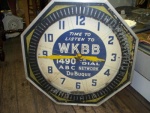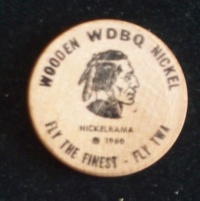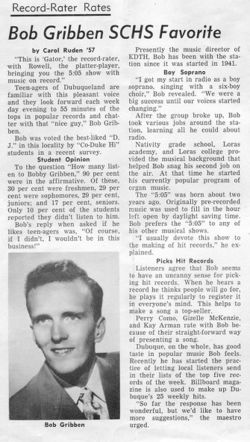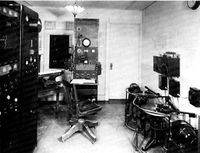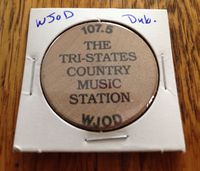Encyclopedia Dubuque
"Encyclopedia Dubuque is the online authority for all things Dubuque, written by the people who know the city best.”
Marshall Cohen—researcher and producer, CNN
Affiliated with the Local History Network of the State Historical Society of Iowa, and the Iowa Museum Association.
RADIO: Difference between revisions
No edit summary |
No edit summary |
||
| Line 20: | Line 20: | ||
[[Image:wkbb.jpg|left|thumb|250px|Matchbook]] | [[Image:wkbb.jpg|left|thumb|250px|Matchbook]] | ||
Audience programs, such as the Nut Sundae Club, were broadcast from the Gold Room of the Julien in the 1930s and attracted standing room crowds. In 1943, Walter Klauer sold WKBB to the Dubuque Broadcasting Company, a group of local investors. (12) These included many of the prominent names in the community including Charles Landon, [[ROSHEK, John J.|John J. ROSHEK]], Dr. Anthony Pfohl, [[O'CONNOR, Francis J.|Francis J. O'CONNOR]], [[STAMPFER, Thomas M.|Thomas M. STAMPFER]], [[ | Audience programs, such as the Nut Sundae Club, were broadcast from the Gold Room of the Julien in the 1930s and attracted standing room crowds. In 1943, Walter Klauer sold WKBB to the Dubuque Broadcasting Company, a group of local investors. (12) These included many of the prominent names in the community including Charles Landon, [[ROSHEK, John J.|John J. ROSHEK]], Dr. Anthony Pfohl, [[O'CONNOR, Francis J.|Francis J. O'CONNOR]], [[STAMPFER, Thomas M.|Thomas M. STAMPFER]], [[YIANNIAS, James N.|James N. YIANNIAS]], and [[INTERSTATE FINANCE CORPORATION]]. (13) In May, 1946 WKBB was transferred from the Julien to fine studios on the second floor of the [[FIRST NATIONAL BANK OF DUBUQUE]] Building at Fifth and Main Streets. (14) | ||
WDBQ-FM at 103.3, Dubuque's first frequency modulation (FM) radio station began broadcasting in 1947. WDBQ-AM at 1490 went on the air in 1952. (15) In 1957 John J. Roshek sold the station to a partnership including | WDBQ-FM at 103.3, Dubuque's first frequency modulation (FM) radio station began broadcasting in 1947. WDBQ-AM at 1490 went on the air in 1952. (15) In 1957 John J. Roshek sold the station to a partnership including Philip T. Kelly and Hart Cardozo of St. Paul, Minnesota. Kelly, concerned with finances, moved the operation from the second floor of First National Bank to a transmitter building at [[FLORA PARK]] in 1958. In the early 1960s, the station was again moved to the penthouse of the Fischer Building. The station was moved in 1968 to 12th and Iowa where it remained until 1987 when it was relocated to Asbury. (16) | ||
[[KFMD-FM D-93 RADIO]] began broadcasting in 1967. | [[KFMD-FM D-93 RADIO]] began broadcasting in 1967. | ||
| Line 39: | Line 39: | ||
The new station moved quickly to establish itself. Live talent was valuable in the beginning days of KDTH, and musicians and actors were in demand. A new program “Dinner with the Smiths,” slanted to entertain the farm audience, was broadcast in September 1941. The first regularly scheduled program to originate from KDTH over the Mutual Broadcasting System was “The Junior Musicale.” KDTH aired the first outdoor concert of the Dubuque Symphony Orchestra held at Loras College Stadium when its new band shell was dedicated. A special broadcast was made from the [[ICE HARBOR]] in June 1941 when a new boat was launched – a U.S. Guard cutter--by the [[DUBUQUE BOAT AND BOILER WORKS]]. In July 1941 a mobile unit was purchased giving KDTH a wider range and allowed the station to report more events on location. (23) | The new station moved quickly to establish itself. Live talent was valuable in the beginning days of KDTH, and musicians and actors were in demand. A new program “Dinner with the Smiths,” slanted to entertain the farm audience, was broadcast in September 1941. The first regularly scheduled program to originate from KDTH over the Mutual Broadcasting System was “The Junior Musicale.” KDTH aired the first outdoor concert of the Dubuque Symphony Orchestra held at Loras College Stadium when its new band shell was dedicated. A special broadcast was made from the [[ICE HARBOR]] in June 1941 when a new boat was launched – a U.S. Guard cutter--by the [[DUBUQUE BOAT AND BOILER WORKS]]. In July 1941 a mobile unit was purchased giving KDTH a wider range and allowed the station to report more events on location. (23) | ||
In May 1952 joined the National Broadcasting Company. It moved to the American Broadcasting Company in March 1956, and rejoined NBC in December 1964. It later became a member of the Columbia Broadcasting System. (24) | In May 1952 KDTH joined the National Broadcasting Company. It moved to the American Broadcasting Company in March 1956, and rejoined NBC in December 1964. It later became a member of the Columbia Broadcasting System. (24) | ||
In 1967 KDTH announced the formation of a sister station with call letters KFMD. Then one of the most powerful radio facilities in the Midwest, KFMD was expected to broadcast to twenty-one thousand square miles in Iowa, Illinois, and Wisconsin. | In 1967 KDTH announced the formation of a sister station with call letters KFMD. Then one of the most powerful radio facilities in the Midwest, KFMD was expected to broadcast to twenty-one thousand square miles in Iowa, Illinois, and Wisconsin. | ||
An application in 1976 was filed by KDTH with the Federal Communications Commission to increase night time power from 1,000 to 5,000 watts and replace its present three towers in East Dubuque with four towers. The application was one of the first to be filed with the FCC since 1975 when the commission had decided to lift a freeze that had been in effect for more than ten years on AM radio changes. The proposed change would allow the station to broadcast over 268 square miles of new area and an estimated 15,600 people. Construction of the towers was not expected to begin before mid-1977. (25) | |||
[[File:D93.jpg|200px|thumb|left|This is the weekly music survey from D93, KFMD-FM 92.9. At this time D93 called their format "The Love Rock." The date is March 6, 1981 and Styx is #1 with "The Best of Times." Ronnie Milsap is #2 with "Smoky Mountain Rain." The survey was compiled by music director Steve Sesterhenn.]]Beginning in July 1975, KFMD changed its format from "easy listening" to "Love Rock," a blend of recent hit tunes, the top 24 hits each week, and top hits since 1957. In April 1984, KDTH announced that KFMD would begin a new image with new call letters. Radio announcers began identifying the station's frequency as 92.9 instead of the previously used "D93" for its location on the radio dial. KAT-FM became the sponsor of the popular [[SATURDAY NIGHT KAT CRUISE]]. | [[File:D93.jpg|200px|thumb|left|This is the weekly music survey from D93, KFMD-FM 92.9. At this time D93 called their format "The Love Rock." The date is March 6, 1981 and Styx is #1 with "The Best of Times." Ronnie Milsap is #2 with "Smoky Mountain Rain." The survey was compiled by music director Steve Sesterhenn.]]Beginning in July 1975, KFMD changed its format from "easy listening" to "Love Rock," a blend of recent hit tunes, the top 24 hits each week, and top hits since 1957. In April 1984, KDTH announced that KFMD would begin a new image with new call letters. Radio announcers began identifying the station's frequency as 92.9 instead of the previously used "D93" for its location on the radio dial. KAT-FM became the sponsor of the popular [[SATURDAY NIGHT KAT CRUISE]]. | ||
By 1977 the music of Andy Williams, Tony Bennett, and Perry Como had all but disappeared as FM stations forced a decline in AM radio. Gradually, however, nostalgia or as other termed it "good music" began to reappear. In 1987 an estimated two hundred markets had developed. WDBQ broadcast "contemporary melodic music and nostalgia from 6:00 pm. to midnight Monday through Saturday on "Moments to Remember," named after a song recorded by the Four Lads. The playlist was created by Paul Hemmer who provided at least half of the 2,500 songs in the "Moments" library from his own collection. Music carried on the program featured singers and vocal groups of the 1930s through 1970s, big bands and contemporary vocalists. Remakes of some classics allowed older songs to be played along with more modern without a noticeable difference in sound quality. ( | By 1977 the music of Andy Williams, Tony Bennett, and Perry Como had all but disappeared as FM stations forced a decline in AM radio. Gradually, however, nostalgia or as other termed it "good music" began to reappear. In 1987 an estimated two hundred markets had developed. WDBQ broadcast "contemporary melodic music and nostalgia from 6:00 pm. to midnight Monday through Saturday on "Moments to Remember," named after a song recorded by the Four Lads. The playlist was created by Paul Hemmer who provided at least half of the 2,500 songs in the "Moments" library from his own collection. Music carried on the program featured singers and vocal groups of the 1930s through 1970s, big bands and contemporary vocalists. Remakes of some classics allowed older songs to be played along with more modern without a noticeable difference in sound quality. (26) | ||
[[Image:imp218.jpg|left|thumb|250px|Studio "A" of radio station WKBB looked like this when the station made its broadcasts from the mezzanine of the Julien Hotel. Studio "B" was located in another room behind the black curtain. Photo courtesy: Paul Hemmer]] | [[Image:imp218.jpg|left|thumb|250px|Studio "A" of radio station WKBB looked like this when the station made its broadcasts from the mezzanine of the Julien Hotel. Studio "B" was located in another room behind the black curtain. Photo courtesy: Paul Hemmer]] | ||
| Line 55: | Line 57: | ||
[[Image:mission-2.jpg|left|thumb|200px|Photo courtesy: Bob Reding]]Other radio stations in the Dubuque area have addressed specific audiences. In the spring of 1980 an FM operation began its religious-oriented programming from the penthouse studio in the Fischer Building. This station, KLXL, was managed by Mrs. Marge Bearden. WJOD (103.3 FM), a radio station broadcasting a country music format, was originally based in Galena, Illinois, and broadcast on a frequency of 107.5. Initially playing adult contemporary, the station switched to a country music format. | [[Image:mission-2.jpg|left|thumb|200px|Photo courtesy: Bob Reding]]Other radio stations in the Dubuque area have addressed specific audiences. In the spring of 1980 an FM operation began its religious-oriented programming from the penthouse studio in the Fischer Building. This station, KLXL, was managed by Mrs. Marge Bearden. WJOD (103.3 FM), a radio station broadcasting a country music format, was originally based in Galena, Illinois, and broadcast on a frequency of 107.5. Initially playing adult contemporary, the station switched to a country music format. | ||
In April, 1991 "super audio" commercial-free channels were offered on cable FM by TCI which also provided [[TELEVISION]] reception in Dubuque. Subscribers to TCI, for an additional fee, would receive the necessary wiring materials to receive the service which offered "Light N' Lively Rock, "Classic Hits," and "America's Country Favorites." ( | In April, 1991 "super audio" commercial-free channels were offered on cable FM by TCI which also provided [[TELEVISION]] reception in Dubuque. Subscribers to TCI, for an additional fee, would receive the necessary wiring materials to receive the service which offered "Light N' Lively Rock, "Classic Hits," and "America's Country Favorites." (27) | ||
Suffering a decline in ratings led KDFX-FM, also called Fox 102, in October 1992 to change much of its musical programming. Decisions in this area would be left to Satellite Music Network, a Dallas company that would beam songs via satellite to the station. ( | Suffering a decline in ratings led KDFX-FM, also called Fox 102, in October 1992 to change much of its musical programming. Decisions in this area would be left to Satellite Music Network, a Dallas company that would beam songs via satellite to the station. (28) | ||
In early April 1994, country music station KIKR-FM began broadcasting in Dubuque. The following week, the owners of WJOD-FM in Galena in April 1994 completed final negotiations to purchase the programming and broadcast time of KGGY-FM in Dubuque. Plans called for keeping the KGGY call letters but the station would be identified as Y-102. While the station had been playing "oldies," the new format would be "hot country" identified as current music and "old" no older than 2-2.5 years. ( | In early April 1994, country music station KIKR-FM began broadcasting in Dubuque. The following week, the owners of WJOD-FM in Galena in April 1994 completed final negotiations to purchase the programming and broadcast time of KGGY-FM in Dubuque. Plans called for keeping the KGGY call letters but the station would be identified as Y-102. While the station had been playing "oldies," the new format would be "hot country" identified as current music and "old" no older than 2-2.5 years. (29) | ||
In October 1997 [[CUMULUS MEDIA]] began the process of securing Federal Communications Commission approval for the purchase of WBBQ-AM, KLYV-FM, WJOD-FM and KXGE-FM from Communications Properties, Inc. ( | In October 1997 [[CUMULUS MEDIA]] began the process of securing Federal Communications Commission approval for the purchase of WBBQ-AM, KLYV-FM, WJOD-FM and KXGE-FM from Communications Properties, Inc. (30) In November Cumulus announced its plans to purchase KIKR-FM, a Dubuque station which had been on the air since 1994, from Phil Fisher, of Madison, Wisconsin. (31) | ||
On March 17, 2000 Woodward Communications announced the sale of KDTH-AM and KATF-FM to Nobles Broadcasting of Fond du Lac, Wisconsin. Nobles formed Radio Dubuque, Inc. including KGRR-FM, independently owned by [[HEMMER, Paul|Paul HEMMER]]. ( | On March 17, 2000 Woodward Communications announced the sale of KDTH-AM and KATF-FM to Nobles Broadcasting of Fond du Lac, Wisconsin. Nobles formed Radio Dubuque, Inc. including KGRR-FM, independently owned by [[HEMMER, Paul|Paul HEMMER]]. (32) | ||
[[Image:klyv.jpg|left|thumb|150px|]] | [[Image:klyv.jpg|left|thumb|150px|]] | ||
| Line 121: | Line 123: | ||
24. Kruse, Len. "Radio Days--WDBQ," p. 52 | 24. Kruse, Len. "Radio Days--WDBQ," p. 52 | ||
25. Kirchen, Rich, "Nostalgia Radio Revives Memories of Era Gone By," ''Telegraph Herald'', September 3, 1987, p. 15 | 25. "KDTH Asks for More Night Power," ''Telegraph Herald'', March 14, 1976, p. 19 | ||
26. Kirchen, Rich, "Nostalgia Radio Revives Memories of Era Gone By," ''Telegraph Herald'', September 3, 1987, p. 15 | |||
27. Arnold, Bill. "Cable Service to Grow," ''Telegraph Herald'', March 21, 1991, p. 1 | |||
28. Bergstrom, Kathy. "Fox Turning to Dallas Turntable, More Variety," ''Telegraph Herald'', October 27, 1992, p. 3A | |||
29. Bergstrom, Kathy. "Station Owners Add WJOD, KGGY to Fold," ''Telegraph Herald'', January 18, 1997, p. 2. Online: https://news.google.com/newspapers?nid=aEyKTaVlRPYC&dat=19970118&printsec=frontpage&hl=en | |||
30. Bergstrom, Kathy. "Galena Station Owners Negotiate to Buy KGGY-FM," ''Telegraph Herald'', April 8, 1994, p. 3A | |||
31. Bergstrom, Kathy. "Cumulus Accumulates Another Radio Station," ''Telegraph Herald'', Telegraph Herald, November 12, 1997, p. 3A. Online: https://news.google.com/newspapers?nid=aEyKTaVlRPYC&dat=19971112&printsec=frontpage&hl=en | |||
32. "Chronology," ''Telegraph Herald'', January 1, 2001, p. 30 | |||
Revision as of 23:25, 19 August 2019
RADIO. "Radio shows" had a different meaning in 1925 than might be expected. On February 5, 6, and 7th, the first exhibition of its kind in Dubuque brought "radio experts" to explain different "receiving sets."
Sets from the simple one tube regenerative to the
five, six and even eight-tube superhetrodynes will
be exhibited. (1)
WIBJ, a local station sponsored by the TELEGRAPH HERALD, went on the air for one week in February of 1926 to broadcast local entertainment programs from the stage of the GRAND OPERA HOUSE. No permanent broadcasting followed. Other temporary radio stations in Dubuque included WIBM in 1926 and WHBL in 1927. Broadcasts regularly featured local talent.
WKBB's call letters existed when the station was first on the air in Joliet, Illinois. (2) On September 30, 1925, radio station WKBB Joliet made its first broadcast at a time when there were only 121 radio stations in forty states. The license belonged to the Sanders Brothers, owners of Joliet's largest tire store. WKBB operated at 100 watts of power on 1310 kilocycles shared with station WCLS also in Joliet. On March 28, 1928 the Davis Amendment to the Radio Act of 1927 stated that radio stations had to be equally divided among five geographical zones in the country and among the states within each zone a quota system. Iowa and Illinois were both over quota. WKBB's transmitter had to stay within Illinois. (3)
In March 1932 WKBB Joliet made an application to the Federal Radio Commission (FRC) to relocate their transmitter to East Dubuque, Illinois. Dubuque did not have a radio station and the closest one, KWCR, in Cedar Rapids was too weak. Although the move was protested, the FRC approved the application on May 27, 1933. The new facility was located on a high bluff in the area of the Hilltop Casino. (4)
Walter E. KLAUER purchased control of the station from the Saunders brothers. WKBB began transmitting in East Dubuque on October 30, 1933, as a Columbia Broadcasting affiliate. (5)
In 1937 new studios and offices were opened on the mezzanine floor of the the Julien Hotel (now the HOTEL JULIEN DUBUQUE). (6) Under FRC rules, 51% of the station's identification breaks had to be made from the studio in East Dubuque because the station was licensed in Illinois. Announcers were usually found in the Dubuque studios with the engineers remaining in East Dubuque. (7) On August 9, 1934 WKBB increased its programming to 89 hours per week beginning at 7:00 a.m. and ending at 9:00 p.m. (8)
In 1927 the Federal Communications Commission (FCC) was given the power to license stations according to technical capabilities rather than population. This allowed WKBB to expand. Engineers, and radio consultants were hired in 1936 to find the best location for a new transmitter. (9) In November 1939, a new tower and transmitter were constructed along Pennsylvania Avenue near FLORA PARK. (10) On November 5, 1939 Jim Carpenter, the general manager of WKBB, was able to announce WKBB, "the radio voice of Iowa's Key City, Dubuque, 1500 on your dial..." Dubuque's first amplitude modulation (AM) radio station, became a 250-watt station broadcasting throughout the day.
WKBB became affiliated with the Blue Network of the National Broadcasting Company (NBC) on May 10, 1940. In March 1941 the station joined the International News Service to acquire up-to-date news. On March 29, 1941, as part of America's shift to new frequencies, WKBB was moved from 1500 to 1490 kilocycles. (11)
Audience programs, such as the Nut Sundae Club, were broadcast from the Gold Room of the Julien in the 1930s and attracted standing room crowds. In 1943, Walter Klauer sold WKBB to the Dubuque Broadcasting Company, a group of local investors. (12) These included many of the prominent names in the community including Charles Landon, John J. ROSHEK, Dr. Anthony Pfohl, Francis J. O'CONNOR, Thomas M. STAMPFER, James N. YIANNIAS, and INTERSTATE FINANCE CORPORATION. (13) In May, 1946 WKBB was transferred from the Julien to fine studios on the second floor of the FIRST NATIONAL BANK OF DUBUQUE Building at Fifth and Main Streets. (14)
WDBQ-FM at 103.3, Dubuque's first frequency modulation (FM) radio station began broadcasting in 1947. WDBQ-AM at 1490 went on the air in 1952. (15) In 1957 John J. Roshek sold the station to a partnership including Philip T. Kelly and Hart Cardozo of St. Paul, Minnesota. Kelly, concerned with finances, moved the operation from the second floor of First National Bank to a transmitter building at FLORA PARK in 1958. In the early 1960s, the station was again moved to the penthouse of the Fischer Building. The station was moved in 1968 to 12th and Iowa where it remained until 1987 when it was relocated to Asbury. (16)
KFMD-FM D-93 RADIO began broadcasting in 1967.
In 1974 WDBQ announced an all-new FM radio station, KIWI, at 105 on the radio dial. The featured music was current top selling records with emphasis on country, big band, and show music. The call letters of KIWI in 1982 became KLYV-FM with a change to playing contemporary hits. In 1994, the announcement was made by Communications Properties, the owner of WDBQ-AM and KLYV-FM, that James and Robert Klauer had become investors. The company, which also owned two radio stations in Albert Lea, Minnesota, had been owned by Phillip Kelly since 1978. Kelly commented at the time that with the rapidly changing industry the addition of new investors gave the company a broader base of resources. (17)
The business offices were moved to the Fischer Building in 1961 and the studios to the penthouse of the Fischer Building in 1962. The station's move to 12th and Iowa occurred in early 1970. (18) The steamboat logo of WDBQ was unveiled to Dubuque in 1978. Live radar to identify severe weather was brought to the station in 1981. Broadcasting in stereo started in January, 1984. (19)
In 1940 the United States Supreme Court in the "Free Enterprise Case" or "Sanders Case" was asked to rule on whether the Federal Communications Commission was obligated to consider potential economic injury to existing radio stations in determining whether to grant or withhold a license to a nearby station. The Court ruled that there was no such obligation. (20)
With this ruling, the TELEGRAPH HERALD was able to file an application for a station to compete with WKBB. In the fall of 1940, the newspaper purchased the Hoerrman Press Building on the southwest corner of Eighth Avenue and Bluff. The building was demolished and construction begun on a home for a new radio station, KDTH.
KDTH, a part of the Mutual Broadcasting System, began operations in Dubuque on May 4, 1941. (21) KDTH signed on at a power of 1000 watts with a 3-tower array at its transmitter site in East Dubuque, Illinois. (22) A special dedication program was scheduled at 2:00 p.m. Regular broadcasting began on May 5, 1941, at frequency 1370. Through KDTH, Dubuque became the first city in the Midwest to be linked with the Associated Press "Newscast" wire which carried domestic and foreign news along with feature stories. The new station announced that it would broadcast from 6:00 a.m. until midnight on weekdays and from 8:00 a.m. until midnight on Sundays.
The new station moved quickly to establish itself. Live talent was valuable in the beginning days of KDTH, and musicians and actors were in demand. A new program “Dinner with the Smiths,” slanted to entertain the farm audience, was broadcast in September 1941. The first regularly scheduled program to originate from KDTH over the Mutual Broadcasting System was “The Junior Musicale.” KDTH aired the first outdoor concert of the Dubuque Symphony Orchestra held at Loras College Stadium when its new band shell was dedicated. A special broadcast was made from the ICE HARBOR in June 1941 when a new boat was launched – a U.S. Guard cutter--by the DUBUQUE BOAT AND BOILER WORKS. In July 1941 a mobile unit was purchased giving KDTH a wider range and allowed the station to report more events on location. (23)
In May 1952 KDTH joined the National Broadcasting Company. It moved to the American Broadcasting Company in March 1956, and rejoined NBC in December 1964. It later became a member of the Columbia Broadcasting System. (24)
In 1967 KDTH announced the formation of a sister station with call letters KFMD. Then one of the most powerful radio facilities in the Midwest, KFMD was expected to broadcast to twenty-one thousand square miles in Iowa, Illinois, and Wisconsin.
An application in 1976 was filed by KDTH with the Federal Communications Commission to increase night time power from 1,000 to 5,000 watts and replace its present three towers in East Dubuque with four towers. The application was one of the first to be filed with the FCC since 1975 when the commission had decided to lift a freeze that had been in effect for more than ten years on AM radio changes. The proposed change would allow the station to broadcast over 268 square miles of new area and an estimated 15,600 people. Construction of the towers was not expected to begin before mid-1977. (25)
Beginning in July 1975, KFMD changed its format from "easy listening" to "Love Rock," a blend of recent hit tunes, the top 24 hits each week, and top hits since 1957. In April 1984, KDTH announced that KFMD would begin a new image with new call letters. Radio announcers began identifying the station's frequency as 92.9 instead of the previously used "D93" for its location on the radio dial. KAT-FM became the sponsor of the popular SATURDAY NIGHT KAT CRUISE.
By 1977 the music of Andy Williams, Tony Bennett, and Perry Como had all but disappeared as FM stations forced a decline in AM radio. Gradually, however, nostalgia or as other termed it "good music" began to reappear. In 1987 an estimated two hundred markets had developed. WDBQ broadcast "contemporary melodic music and nostalgia from 6:00 pm. to midnight Monday through Saturday on "Moments to Remember," named after a song recorded by the Four Lads. The playlist was created by Paul Hemmer who provided at least half of the 2,500 songs in the "Moments" library from his own collection. Music carried on the program featured singers and vocal groups of the 1930s through 1970s, big bands and contemporary vocalists. Remakes of some classics allowed older songs to be played along with more modern without a noticeable difference in sound quality. (26)
Over the years, Dubuque originated several programs for national audiences. Nationally known commentator Paul Harvey broadcast from studios belonging to KDTH. Radio station WDBQ hosted an episode of the popular "Don McNeill's Breakfast Club" from a boat moored in the ICE HARBOR. 'The Junior Musicale" produced by Arnie Stierman for Saturday morning audiences listening to the Mutual Broadcasting System, was Dubuque's first regularly scheduled network program.
Other radio stations in the Dubuque area have addressed specific audiences. In the spring of 1980 an FM operation began its religious-oriented programming from the penthouse studio in the Fischer Building. This station, KLXL, was managed by Mrs. Marge Bearden. WJOD (103.3 FM), a radio station broadcasting a country music format, was originally based in Galena, Illinois, and broadcast on a frequency of 107.5. Initially playing adult contemporary, the station switched to a country music format.
In April, 1991 "super audio" commercial-free channels were offered on cable FM by TCI which also provided TELEVISION reception in Dubuque. Subscribers to TCI, for an additional fee, would receive the necessary wiring materials to receive the service which offered "Light N' Lively Rock, "Classic Hits," and "America's Country Favorites." (27)
Suffering a decline in ratings led KDFX-FM, also called Fox 102, in October 1992 to change much of its musical programming. Decisions in this area would be left to Satellite Music Network, a Dallas company that would beam songs via satellite to the station. (28)
In early April 1994, country music station KIKR-FM began broadcasting in Dubuque. The following week, the owners of WJOD-FM in Galena in April 1994 completed final negotiations to purchase the programming and broadcast time of KGGY-FM in Dubuque. Plans called for keeping the KGGY call letters but the station would be identified as Y-102. While the station had been playing "oldies," the new format would be "hot country" identified as current music and "old" no older than 2-2.5 years. (29)
In October 1997 CUMULUS MEDIA began the process of securing Federal Communications Commission approval for the purchase of WBBQ-AM, KLYV-FM, WJOD-FM and KXGE-FM from Communications Properties, Inc. (30) In November Cumulus announced its plans to purchase KIKR-FM, a Dubuque station which had been on the air since 1994, from Phil Fisher, of Madison, Wisconsin. (31)
On March 17, 2000 Woodward Communications announced the sale of KDTH-AM and KATF-FM to Nobles Broadcasting of Fond du Lac, Wisconsin. Nobles formed Radio Dubuque, Inc. including KGRR-FM, independently owned by Paul HEMMER. (32)
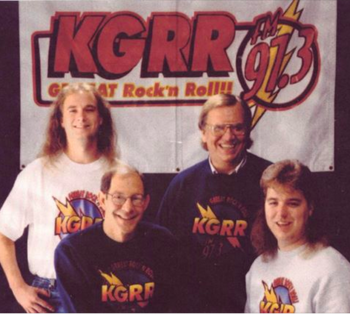
Dubuque radio station personalities became well known. Paul HEMMER, one of the Tri-State's most popular bandleaders, constructed 97.3 KGRR-FM in 1994. In 2000 he and two partners formed RADIO DUBUQUE. Gerald "Red" McALEECE retired from KDTH after thirty-seven years producing agricultural and sports programs. Gordon KILGORE became a news and public affairs favorite of tri-State listeners. Kenneth Gordon, manager of KDTH until 1963, was a founder of the Iowa Tall Corn Network while working in Dubuque. Early names at KDTH also included George FREUND, and Bill and Betty THOMAS.
---
Source:
1. "Dubuque to Stage Radio Show Here February 5,6,7," Telegraph Herald, January 25, 1925, p. 7. Online: http://news.google.com/newspapers?id=8kBFAAAAIBAJ&sjid=pbsMAAAAIBAJ&pg=4585,1313583&dq=radio+in+dubuque&hl=en
2. Hemmer, Paul. e-mail. August 15, 2018
3. Kruse, Len. Unforgettable Radio, Dubuque, Iowa: Union-Hoermann Press, 1993, p. 2
4. Ibid.
5. Hemmer, Paul. e-mail July 9, 2017
6. Ibid.
7. Kruse, Len. Unforgettable Radio., p. 11
8. Ibid. p. 12
9. Ibid., p. 14
10. Kruse, Len. "Radio Days--WDBQ," p. 47
11. Stamm, Michael. Sound Business: Newspapers, Radio, and the Politics of New Media, University of Pennsylvania Press, 2011, p. 91. Online: http://books.google.com/books?id=PXHuUO_UJi4C&pg=PA91&lpg=PA91&dq=WKBB+radio+%28Dubuque%29&source=bl&ots=KEfzIYd9g_&sig=R0gETP1TkcnYd__Plg_1fBlz97g&hl=en&sa=X&ei=hL-gUr3xIs_vqQH64IGgBg&ved=0CGUQ6AEwBw#v=onepage&q=WKBB%20radio%20%28Dubuque%29&f=false
12. Kruse, Len. Unforgettable Radio., p. 15
13. Hemmer, Paul. e-mail, August 15, 2018
14. Kruse, Unforgettable Radio, p. 48
15. Hemmer
16. Ibid.
17. Bergstrom, Kathy. "Klauers Buy Part of WDBQ," Telegraph Herald, July 21, 1994, p. 2
18. Kruse
19. Hemmer
20. Kruse, p. 49
21. "KDTH, Dubuque, to Join Mutual System on May 1, Chicago Tribune, April 27, 1941, p. 1W, Online: http://pqasb.pqarchiver.com/chicagotribune/doc/176506319.html?FMT=CITE&FMTS=CITE:AI&type=historic&date=Apr%2027,%201941&author=&pub=Chicago%20Tribune&edition=&startpage=&desc=KDTH,%20Dubuque,%20to%20Join%20Mutual%20System%20on%20May%201
22. "A Brief History of AM 1370 KDTH-The Voice of the Tri-States," Online: http://www.kdth.com/
23. Ibid.
24. Kruse, Len. "Radio Days--WDBQ," p. 52
25. "KDTH Asks for More Night Power," Telegraph Herald, March 14, 1976, p. 19
26. Kirchen, Rich, "Nostalgia Radio Revives Memories of Era Gone By," Telegraph Herald, September 3, 1987, p. 15
27. Arnold, Bill. "Cable Service to Grow," Telegraph Herald, March 21, 1991, p. 1
28. Bergstrom, Kathy. "Fox Turning to Dallas Turntable, More Variety," Telegraph Herald, October 27, 1992, p. 3A
29. Bergstrom, Kathy. "Station Owners Add WJOD, KGGY to Fold," Telegraph Herald, January 18, 1997, p. 2. Online: https://news.google.com/newspapers?nid=aEyKTaVlRPYC&dat=19970118&printsec=frontpage&hl=en
30. Bergstrom, Kathy. "Galena Station Owners Negotiate to Buy KGGY-FM," Telegraph Herald, April 8, 1994, p. 3A
31. Bergstrom, Kathy. "Cumulus Accumulates Another Radio Station," Telegraph Herald, Telegraph Herald, November 12, 1997, p. 3A. Online: https://news.google.com/newspapers?nid=aEyKTaVlRPYC&dat=19971112&printsec=frontpage&hl=en
32. "Chronology," Telegraph Herald, January 1, 2001, p. 30


